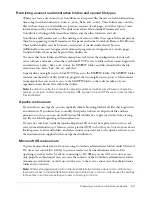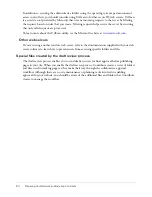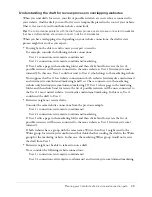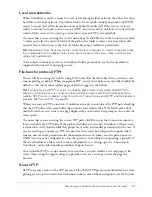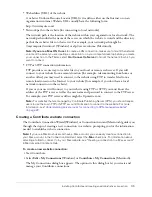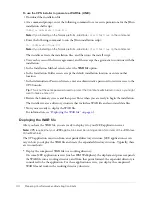
30
Preparing Your Network and Installing Contribute
Suppose User 1 edits a page in the marketing folder and sends it to User 2 for review. The draft
for review is temporarily placed on the website at the root of User 1’s website connection
(www.mysite.com/intranet/). (Remember, User 1 does not have a website connection to the
marketing website.) When User 2 receives the draft, there is a conflict because User 2 has
website connections to the site where the draft for review was placed and also to the website
that contains the original page.
In this case, Contribute has a conflict on how to handle the draft for review, because it expects
the draft for review to be in the same folder as the original page. Because of this conflict, User
2 can send the draft for review or delete the draft only. User 2 cannot edit or publish the draft
for review.
Understanding templates, shared assets, and images in overlapping
websites
Templates in Contribute reside in a folder named Templates in the root folder of each website
connection (for example,
/Templates/contactPage.dwt
). Shared assets and images are also stored
separately for each website and are available to users depending on the role the website
administrator assigned to them for that website.
When you have overlapping website connections within your website, you might have users who
have multiple connections to different parts of your website. When those users edit a page, they
have access to the templates and shared assets for the most nested website connection for the page
and the user.
You must carefully consider where you place your templates, shared assets, and images. For
example, if you place the company logo in the root of the intranet website (www.mysite.com/
intranet/), users who have connections to the marketing website only (www.mysite.com/intranet/
marketing) won’t have access to the logo.
Understanding Contribute network connection types
Contribute lets you connect to websites using one of several network connection types. The
connection type you choose depends upon the infrastructure of your website. For example, if you
are deploying Contribute to update a workgroup’s intranet site, you can, in most instances, use a
local area network connection. However, if the site is hosted through an ISP or other external
resource, you might need to use either an FTP, SFTP, or WebDAV connection.
This section covers the following topics:
•
“Local area networks” on page 32
•
“File transfer protocol (FTP)” on page 32
•
“Secure FTP” on page 33
•
“FTP and SFTP file permissions” on page 33
•
“WebDAV” on page 34








